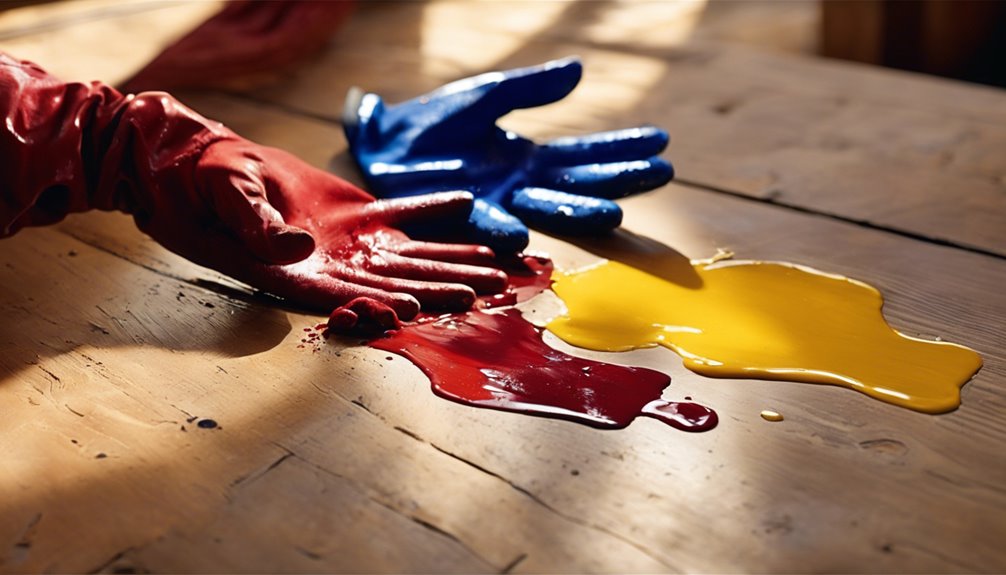To get paint off your wood floor, start by identifying the paint type—water-based or oil-based. Gather your supplies, like a scraper, fine steel wool, or the appropriate solvent; mineral spirits work for oil-based paints, while vinegar can handle water-based types. Always test your chosen method on a small, hidden area first to check for damage. For water-based paint, use warm soapy water and a scrub brush; for oil-based, apply mineral spirits with a rag and gently scrub. Clean the area afterward to remove any residue, ensuring your floor looks pristine. There's more to know about restoring your floor's finish!
Identify the Type of Paint
Before you tackle removing paint from your wood floor, it's crucial to identify the type of paint you're dealing with, since different paints require different removal techniques. Paint types generally fall into two categories: water-based and oil-based. Water-based paints, like latex, tend to have a milder odor and clean up easily with soap and water, while oil-based paints are more durable and require solvents for removal. Understanding these paint characteristics can save you time and effort. For instance, if you find a thick, glossy finish, it's likely oil-based, needing a stronger approach. Conversely, a soft, matte texture suggests water-based paint, which you can often scrub away without harsh chemicals. Knowing this upfront empowers you to choose the right method.
Gather Necessary Supplies
Once you've identified the type of paint on your wood floor, it's time to gather the necessary supplies for an effective removal process. You'll need paint removal tools like a scraper, putty knife, and fine steel wool, depending on the paint's thickness. Additionally, a solvent that matches your paint type—like mineral spirits or vinegar—will be essential. Don't forget to pick up some rags or paper towels for easy cleanup. Protect yourself by wearing gloves, goggles, and a mask to shield against fumes and splashes. Having all these items ready will give you the freedom to tackle the task confidently and efficiently, ensuring your wood floor looks its best without the hassle.
Test on a Small Area
After gathering your supplies, it's wise to test your chosen paint removal method on a small, inconspicuous area of the wood floor. This step guarantees that the test methods and materials you're using won't damage the finish or wood itself. Apply a small amount of your chosen remover, and wait a few minutes before wiping it off. Check for any adverse effects like discoloration or damage.
Here's a simple table to help you choose your test methods and materials:
| Test Method | Test Material | Expected Result |
|---|---|---|
| Paint Remover | Soft Cloth | No damage |
| Vinegar Solution | Cotton Swab | Mild removal |
| Scraper | Plastic Scraper | Minimal wood impact |
| Heat Gun | Old Towel | Controlled paint removal |
Remove Water-Based Paint
To effectively remove water-based paint from your wood floor, you'll first need to gather the right supplies, such as warm soapy water, a scrub brush, and a clean cloth. Once you have everything ready, you can apply specific removal techniques to lift the paint without damaging the wood. Let's explore how to tackle this task step by step.
Gather Necessary Supplies
Before you plunge into removing water-based paint from your wood floor, it's essential to gather the right supplies to make the process efficient and effective. Start by collecting vital paint removal tools and safety equipment to protect yourself and your floor.
| Supplies | Purpose |
|---|---|
| Plastic Scraper | To gently lift paint off the wood |
| Rubbing Alcohol | To dissolve water-based paint |
| Soft Cloth | For wiping and cleaning |
| Bucket | To hold your cleaning solution |
| Gloves | To protect your hands from chemicals |
Having these items on hand will set you up for success and give you the freedom to tackle that paint without worry. Now you're ready to get started!
Apply Removal Techniques
Start by applying rubbing alcohol to a soft cloth, saturating it enough to dissolve the water-based paint. Gently rub the cloth over the paint stain, using a circular motion. You'll start to see the paint lift away. If it's stubborn, let the alcohol sit on the stain for a minute before wiping again. Once the paint is removed, clean the area with warm, soapy water to eliminate any residue. For wood floor care, dry the area thoroughly to prevent moisture damage. Always test any paint removal techniques on a hidden spot first to verify it doesn't harm the finish. With a bit of patience, you can restore your wood floor's beauty and freedom from unsightly stains.
Remove Oil-Based Paint
Although removing oil-based paint from wood floors can seem challenging, with the right approach and materials, it becomes manageable. Start by gathering essential supplies like a paint scraper, mineral spirits, and clean rags. First, test the mineral spirits on a hidden area to verify it won't damage your finish. Once confirmed, apply a small amount to a rag and gently rub the painted area, using paint removal techniques to lift the paint. Be patient, and repeat as necessary. For stubborn spots, a plastic scraper can help, but avoid gouging the wood. After you've removed the paint, clean the area with a damp cloth to eliminate any residue. These floor restoration methods will leave your wood looking refreshed and beautiful.
Clean and Restore the Surface
Once you've removed the paint, it's important to assess the damage to your wood floor. Look for scratches, stains, or discoloration that may need attention before cleaning. Choosing the right cleaner will be vital to restore the surface without causing further harm.
Assessing the Damage
Before diving into the removal process, it is essential to assess the damage to your wood floor thoroughly. A proper damage assessment will help you determine the best course of action. Start with a detailed floor inspection, focusing on the following:
- Extent of Paint Coverage: Identify how much area is affected and the type of paint.
- Wood Condition: Check for scratches, gouges, or discoloration caused by the paint.
- Finish Integrity: Look for any damage to the wood finish that might complicate the cleaning process.
Choosing the Right Cleaner
Choosing the right cleaner is essential to effectively remove paint without damaging your wood floor. Look for cleaning solutions specifically designed for wood, as they're gentler on the surface while still being tough on paint. If you prefer eco-friendly options, consider vinegar mixed with warm water or a biodegradable paint remover. These alternatives are not only safe for your wood but also better for the environment. Always test any cleaner on a small, inconspicuous area first to guarantee it won't harm the finish. When applying the cleaner, use a soft cloth or sponge to avoid scratching the surface. This method lets you restore your floor's beauty without compromising your values or freedom to choose sustainable products.
Frequently Asked Questions
Can I Use a Heat Gun to Remove Paint From Wood Floors?
Yes, you can use a heat gun to remove paint from wood floors. It's an effective method if you're careful. Start by setting the heat gun to a low temperature and keep it moving to avoid damaging the wood. As the paint starts to bubble, use a paint scraper as one of your paint removal tools to gently lift it away. Remember to wear protective gear, and make certain proper ventilation while using heat gun techniques.
Will Removing Paint Damage the Wood Finish?
When you're considering paint removal, it's natural to worry about damaging the wood finish. The method you choose can impact that finish. Using harsh chemicals or excessive heat might strip away the protective layer, leaving the wood vulnerable. To minimize damage, opt for gentler techniques like rubbing alcohol or a paint scraper. Always test your method on a small area first to guarantee you maintain the integrity of your beautiful wood finish.
What if the Paint Is Dried and Hardened?
Imagine a once-vibrant wood floor now marred by hardened paint splatters. Don't worry; there are effective paint removal techniques to restore its beauty. Start by gently scraping the paint with a plastic putty knife, being careful not to gouge the wood. For stubborn spots, apply a solvent, ensuring you follow wood floor care guidelines. Always test in an inconspicuous area first. With patience, your floor can regain its original charm.
Is It Safe to Use Chemical Strippers Indoors?
Using chemical strippers indoors can pose safety risks if you don't take proper precautions. You'll need to guarantee good indoor ventilation to minimize exposure to harmful fumes. It's crucial to check the product's safety guidelines and use appropriate protective gear, like gloves and masks. If you can, work in a well-ventilated area or open windows and doors. Prioritizing chemical safety will help you avoid health issues while working on your project.
How Can I Prevent Paint Spills on My Wood Floor?
To prevent paint spills on your wood floor, you'll want to invest in paint protection products. Lay down floor coverings like drop cloths or plastic sheeting to catch any drips or spills. You can also use painter's tape to secure edges and prevent paint from seeping underneath. Always keep a rag handy for quick clean-ups. This way, you can enjoy your painting projects without worrying about damaging your beautiful wood floors.




